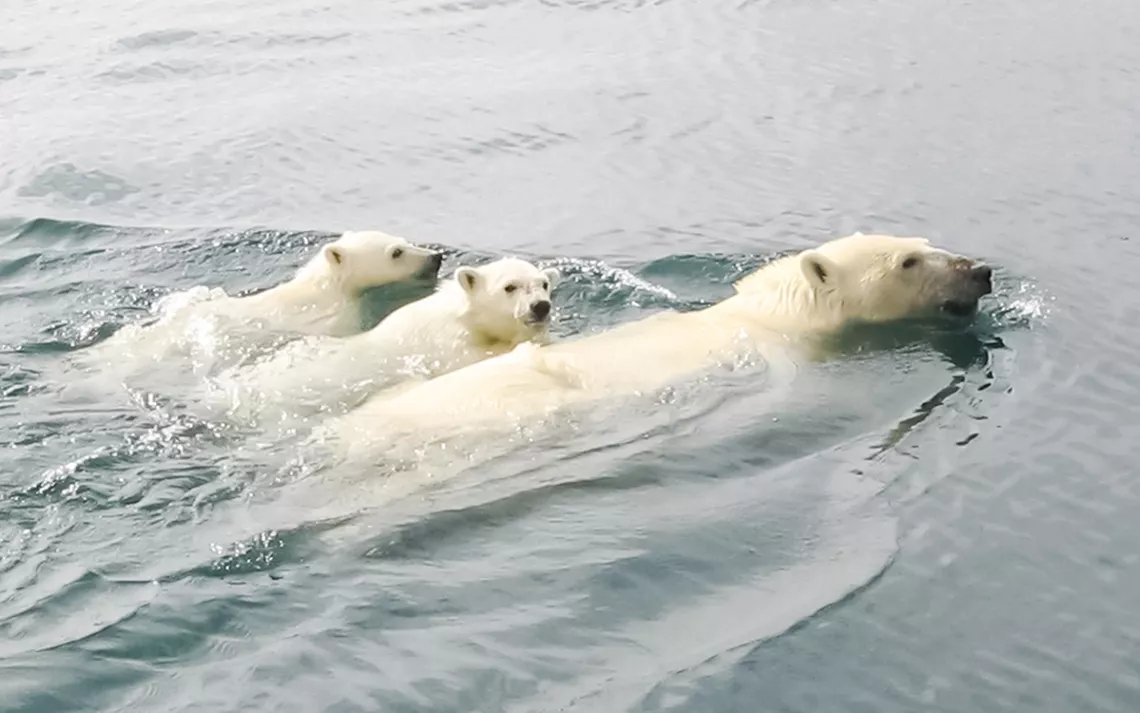Coastal and Seafaring Polar Bears Have Different Chemical Exposures
Changes in the Barents Sea caused by global warming are leading to differences

Photo by avstrailavasin/iStock
Polar bears are in trouble in several different ways. The loss of sea ice due to climate change is making it harder to find food, raise cubs, and find safe places to den. They also face a less visible threat: for decades researchers have recorded high levels of chemical pollutants in their blood and tissue, which could impact their survival. Researchers also noticed something curious about bears in the Barents Sea, the icy body of water between Scandinavia and the North Pole. Bears that lived on the coast and pelagic bears, those that migrate annually to hunt at sea, had very different loads of persistent organic pollutants (POPs)—a class of chemicals used in things like insecticides, flame retardants, and industrial processes.
Now, a new study in the journal Environmental Science & Technology has determined why different bears face different chemical threats, and the results will inform management of a species facing tough times as the climate continues to change.
Lead author Pierre Blévin of the Norwegian Polar Institute and his colleagues examined tissue and blood samples as well as telemetry data from female polar bears near the Svalbard Archipelago between 2011 and 2018.
Each year, researchers visited the area on a vessel from the Polar Institute and subdued the seven-foot-tall, 650-pound female bears. “A helicopter is needed to capture polar bears; bears were immobilized by a remote injection delivered by a dart fired from a helicopter,” senior author Heli Routti, also of the Polar Institute, says. “That immobilizes the bear for an hour during which blood samples, fat biopsies, and hair samples are collected and a satellite telemetry collar is attached.”
By analyzing the bears’ pollutant loads and determining whether they were coast-hugging or sea bears, the team was able to figure out why the two populations had different chemical loads.
The difference has to do with climate change. Because the bears are at the top of the Arctic food chain, any pollutants in the ecosystem move upward and bioaccumulate, or build up, in the tissues of predators. In recent years, the feeding patterns between coastal and pelagic bears have begun to diverge. Because sea ice along the shoreline is less abundant and does not last as long as it used to in the past, bears along the coast aren’t able to venture out onto the ice to hunt as many seals and aquatic animals as they did in the past. Instead, their diets rely more and more on terrestrial food sources.
At the same time, the pelagic bears, which migrate to the edge of Arctic ice to hunt, have farther to travel since the ice edge has receded northward. Marine systems tend to have more contaminants than terrestrial food chains. Since the bears are at the top of the chain, the sea bears are getting contaminants from multiple trophic layers compared with their relatives on shore. And because the sea bears use more energy chasing down their prey, they eat more, increasing their exposure.
Melissa McKinney at McGill University, who studies ecosystem contaminants in the Arctic, points out that it’s hard to say exactly how the increased pollutant loads impact the animal’s health or survival. Researchers can’t test the effects of the pollutants on the polar bears.
Still, she says, there are health consequences to exposure. “Because they’re at the apex of the Arctic marine food web, they tend to have very high levels of contaminants. They can be hundreds or thousands of times higher than they are in the surrounding environment,” she says. “Just the levels alone are levels of concern, and they have these high levels relative to other wildlife species.”
McKinney says that researchers are only beginning to understand how climate changes are impacting the movement of pollutants and how those alterations affect wildlife in the Arctic. She says there are two main mechanisms. The loss of sea ice, the melting of glaciers, and other physical ecosystem changes are impacting how these pollutants reach and accumulate in Arctic systems. At the same time, those same changes are reshuffling the ranges of plants and animals, which cause species like coast polar bears to adapt to a new diet.
Both of those changes can impact the amount of pollutants they encounter. While the new study lays out how this process works in the Barents Sea bears, she cautions that the processes may be different in other Arctic regions depending on the specific environment and changes to sea ice.
In order to save polar bears, which are listed as vulnerable by the IUCN, the organization that oversees the international endangered species list, nations need to finally tackle climate change in a concerted way. But they also need to pay more attention to persistent organic pollutants, which continue to enter the environment.
While many chemicals deemed harmful in the 1970s and 1980s were banned, McKinney says, they were replaced by other chemicals that were eventually discovered to be harmful as well, in a cycle that has continued to contaminate the Arctic.
 The Magazine of The Sierra Club
The Magazine of The Sierra Club